Soaring to new heights
Dubai is taking its aspirations to new heights. With plans to become the world’s first city with a comprehensive air taxi network, the emirate is not only redefining urban mobility but its real estate sector is also setting the stage for a lifestyle that boasts the heights of luxury and extraordinary experiences.
01 March 2024
There’s a great buzz in the Dubai’s high-end construction market, thanks to the emirate’s skyrocketing real estate, fuelled by record-breaking ultra-luxury deals and what is seemingly an unsatiable demand for luxury property. Thousands of new homes are rising across its expanse, catering to an influx of foreign investors seeking a slice of the emirate’s opulent lifestyle.
The UAE has been actively attracting these investors with its open-door approach, which has seen a further relaxation of the golden visa rules last month by cancelling the AED1 million ($272,294) minimum down payment required for people to qualify for this visa through real estate investment. Previously, investors were required to acquire property valued at AED2 million or more to qualify for the 10-year renewable residency programme.
To cater to the upsurge in demand for uber-luxury homes, branded residences are being developed by Dubai’s leading developers in partnership with global titans of luxury, from jewellery houses to automotive icons. Some of these will include homes in Dubai’s proposed second-tallest tower or the world’s tallest or largest residential structure or on a Palm island double the size of its iconic predecessor. No longer are golf course-facing homes adequate; in a bid to offer the extraordinary, developers are offering “Bio Living” concepts and circular outdoor terraces featuring oasis-inspired retreats, and the like.
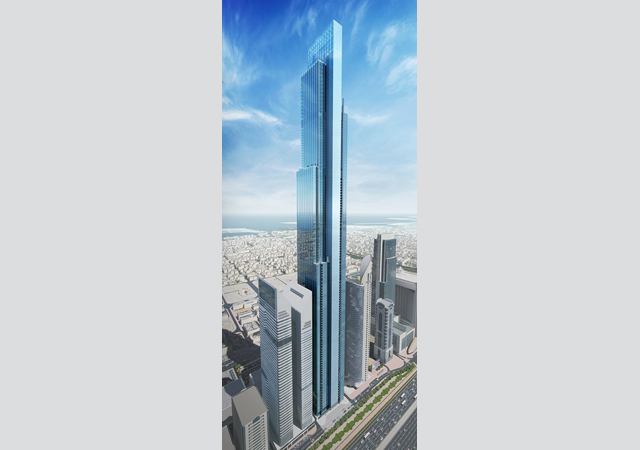 |
|
Burj Azizi ... targeted to be Dubai’s second tallest tower. |
But it’s not just about glitz and glamour. To support its ambitious expansion, Dubai is weaving a web of infrastructure. Roads and bridges are expanding as is its metro network, and massive solar farms are harnessing the desert sun to power this growth. The newly unveiled 30-km Blue Line metro project is just one example, strategically stitching together key areas for seamless connectivity.
Dubai is also set to become the first city in the world to offer air taxis after its transport authority, the Roads & Transport Authority (RTA), has agreed a deal with eVTOL aircraft maker Joby and vertiport provider Skyports Infrastructure.
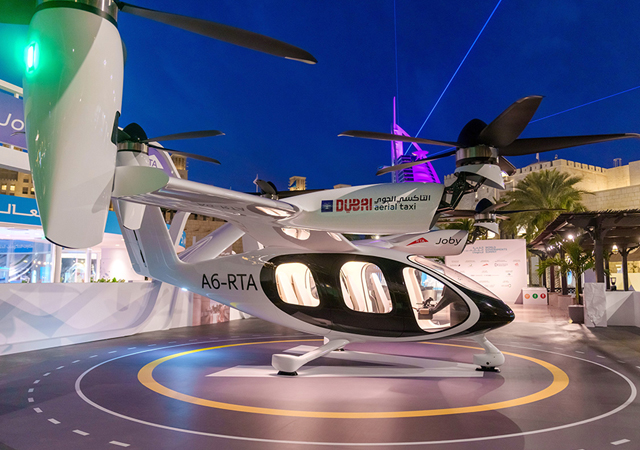 |
|
Air taxis ... expected to be launched in Dubai in 2026. |
All these stupendous developments are driven by a clear vision. The Dubai Economic Agenda (D33) and Dubai 2040 Urban Master Plan chart a course towards becoming the world’s best city to live in. And with each skyscraper and sprawling villa, Dubai inches closer to that goal.
This apart, Dubai has planned a series of transformative projects for this year under the Dubai Social Agenda 33, which is inspired by the overarching theme of ‘Family: The Foundation of Our Nation’. Among such initiatives, the emirate has plans to allocate 3,500 plots of land and 2,300 ready-to-move-in houses valued at a total of AED5.5 billion to citizens across Dubai. These include 2,700 plots in Latifa City and 800 plots in Al Yalayis 5 area. The 2,300 new houses for citizens are located across areas in Al Khawaneej 2, Al Aweer, Wadi Al Amardi, and Hatta.
One of the key objectives of the AED208-billion Dubai Social Agenda programme is to double the number of Emirati families in Dubai within a decade.
Metro
In line with Dubai’s strategy for comprehensive city development, the emirate has announced plans to expand its metro network with the Blue Line, the first metro route crossing Dubai Creek through a 1,300-m viaduct. The route will run 15.5 km underground and 14.5 km above ground.
The 30-km line will consist of nine elevated stations and five underground stations. With key interchange points like the Creek Station on the Green Line, Centrepoint Station on the Red Line, and Dubai International City Station 1, along with the iconic station at Dubai Creek Harbour, the Blue Line is set to be a pivotal element in the ongoing development of the city’s transportation network.
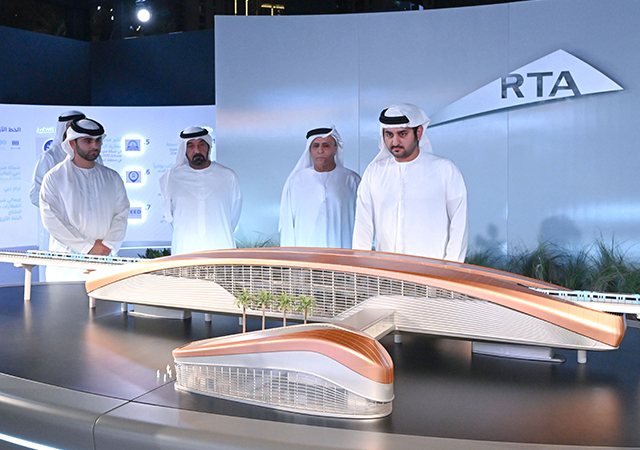 |
|
Dubai officials at the unveiling of plans for the metro’s Blue Line. |
By 2030, the Blue Line is anticipated to serve approximately 200,000 passengers daily, with this figure expected to increase to 320,000 passengers per day by 2040. The line is designed to handle an estimated 56,000 passengers per hour in both directions at a service interval of about 1.5 minutes.
The line will offer a direct connection between Dubai International Airport and nine key areas along the line and the travel time between these destinations is anticipated to range from 10 to 25 minutes.
Upon completion of the Blue Line, Dubai’s total metro network will expand from 101 km to 131 km.
Roads & Bridges
Dubai’s Roads and Transport Authority is at the sharp end in keeping pace with the rapid growth of the city with key road expansion projects. Among them is the Al Shindagha Corridor Improvement Project, one of the largest projects currently being undertaken by the authority at a total cost of AED5.3 billion. The project spans 13 km in total and encompasses the construction of 15 intersections. It is expected to serve about one million people and slash the travel time from 104 minutes to just 16 minutes by 2030.
Due to its massive scope, the project has been split into five phases. It serves Deira and Bur Dubai in addition to several development projects such as Deira Islands, Dubai Seafront, Dubai Maritime City and Port Rashid.
The RTA is also implementing the Umm Suqeim Street Improvement Project, which is crucial to enhance connectivity between east-west transverse streets and north-south vertical streets.
Meanwhile, the authority has joined hands with the master developers of key projects to develop the connectivity with some of the islands. The RTA has entered into a strategic partnership with Shamal Holding to develop entry/exit points for the Dubai Harbour project to ease the movement of visitors and residents. Under the agreement, RTA will undertake the construction of a two-lane bridge in each direction spanning 1,500 m. The bridge will extend from Sheikh Zayed Road to Dubai Harbour, a seafront district nestled between Bluewaters Island and Palm Jumeirah.Once ready, the new bridge will accommodate 6,000 vehicles per hour.
Last September, the RTA signed an agreement with Nakheel to construct a 1,425-m bridge to the Dubai Islands project from Bur Dubai. The bridge features four lanes in each direction.The Dubai Islands project will have direct entry and exit points on the Bur Dubai side through a bridge stretching across the Dubai Creek between the Infinity Bridge and Port Rashid Development Project.
The bridge, which has a total capacity of 16,000 vehicles per hour in both directions, rises 15.5 m above the waters of the Dubai Creek and features a 75-m-wide canal allowing ships of various types to traverse the creek. The project forms a key phase of the Al Shindagha Corridor Improvement Project.
Power & Water
At COP28, the Ministry of Energy and Infrastructure (MoEI) indicated that the UAE Energy Strategy 2050 targets an investment of AED150 billion to AED200 billion on renewable energy by 2030, pushing AED55 billion to advance an array of decarbonisation projects across its diversified value chain by 2030, and an increase of the clean energy capacity from 14.2 GW to 19.8 GW by 2030.
The MoEI is looking to triple the share of renewable energy by 2030, increasing clean energy generation to 32 per cent by 2030, producing 1.4 million tonnes of hydrogen per year by 2030, establishing five hydrogen oases by 2050, incorporating reverse osmosis to expand the UAE’s transition to more efficient desalination methods.
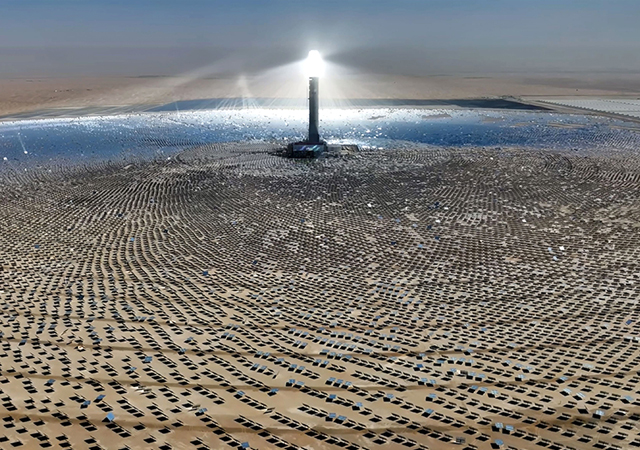 |
|
The fourth phase of the MBR solar park was inaugurated in December. |
Among its most ambitious clean energy projects, work is well advanced on the Mohammed bin Rashid Al Maktoum Solar Park, the largest single-site solar park in the world with a planned capacity of 5,000 MW by 2030.
Involving a total investment of AED50 billion, based on the Independent Power Producer (IPP) model, the solar park is expected to cut 6.5 million tonnes of carbon emissions annually when fully completed.
In December, HH Sheikh Mohammed bin Rashid Al Maktoum, Vice President and Prime Minister of the UAE and Ruler of Dubai, inaugurated the largest concentrated solar power (CSP) project in the world, within the fourth phase of the park.
The 950 MW Phase Four is the biggest investment project that uses three hybrid technologies – 600 MW from a parabolic basin complex, 100 MW from the CSP tower, and 250 MW from photovoltaic solar panels. The project features the tallest solar tower in the world, standing at 263.1 m high, and the largest thermal energy storage capacity of 5,907 megawatt hours (MWh), said Dubai Electricity and Water Authority (Dewa).
The project will provide about 320,000 residences with clean and sustainable energy and will cut carbon emissions by about 1.6 million tonnes annually.
The 900 MW fifth phase of the solar park was inaugurated in June last year and is providing clean energy to around 270,000 residences in Dubai, while reducing 1.18 million tonnes of carbon emissions annually. The project, implemented based on IPP model, is a partnership between Dewa (60 per cent) and a consortium led by Saudi-based utility project developer Acwa Power and Gulf Investment Corporation (40 per cent) through Shuaa Energy 3.
Last September, Dewa awarded a AED5.51-billion contract to Abu Dhabi-based Masdar for the construction of the 1,800MW sixth phase of the project. When operational in stages starting from the fourth quarter of this year, the sixth phase will provide clean energy to approximately 540,000 residences and reduce 2.36 million tonnes of carbon emissions annually. The total capacity of the solar energy projects commissioned at the solar park has reached 2,427MW.
The share of clean energy in Dubai’s energy mix is about 16.3 per cent of its installed capacity - this percentage will reach 24 per cent in 2026 with the completion of the solar park.
In the water sector, work is in progress on the Hassyan Phase One Independent Water Producer (IWP) project, being set up at an investment of AED3.35 billion. Acwa Power is responsible for the construction and operation of the 180-million-gallons-per-day (MGD) sea water reverse osmosis (SWRO) plant.
According to Dewa, the project is the largest of its kind in the world for water production based on SWRO technology using solar energy. This is the Dubai utility’s first IWP model project. The project is due for completion in 2026.
Real Estate
According to global real estate services provider Savills, Dubai’s residential sector has just had its best year on record. Transaction activity grew by 29 per cent year-on-year to an all-time high of 118,200 units last year – the first time the total transaction volume surpassed the 100,000-mark. The majority of the homes – 65,000 – were sold off-plan in 2023.
The residential market has witnessed an upward trend since 2021 and within two years, activity levels have more than doubled. Dubai is now among the few global cities that have sustained growth in demand, which started after the Covid-19-induced restrictions were lifted, says Savills in its Dubai Property Market report for 2023.
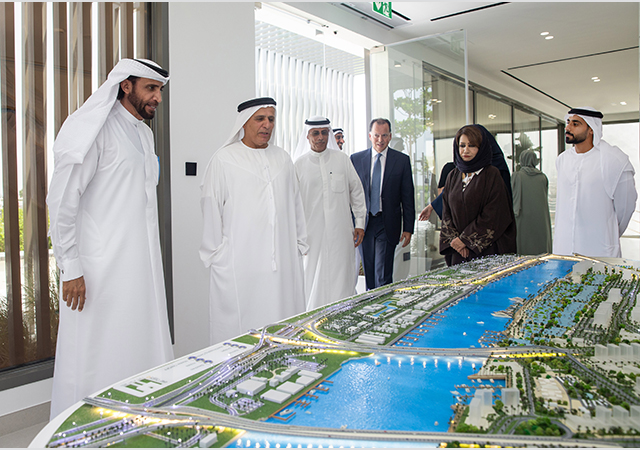 |
|
Officials at the launch of a project to build a 1,425-m bridge to the Dubai Islands project. |
This growth has been attributed to the increase in expatriate population, policies such as the recent change to the rules for real estate investors to qualify for the golden visa, and Dubai’s growing and diversified economy overall, says the global real estate services provider.
Given the pace at which projects are being launched in the emirate, Savills cautions that there may be a risk of oversupply for select assets across a few locations, which may limit any significant increase in average prices going forward.
Over the past year, Dubai has seen numerous developers, both local and international, launch projects on the market with many of them announcing overwhelming response. Most of the recent launches boast unique lifestyles, uber luxury, branded homes, and resort-like amenities.
Among the mega-scale developments launched over the past year are three multi-billion-dollar developments by Emaar Properties, a global property developer - The Heights Country Club and Grand Club Resort unveiled late last month with a total development value of AED96 billion; and The Oasis by Emaar, an AED73.5-billion waterfront luxury lifestyle destination launched in June 2023, which was expanded last month, increasing its land space by 108 per cent (see facing page).
Another UAE developer Omniyat probably deserves a mention for launching a series of projects boasting Dorchester Collection homes (see Page 14); while Damac Properties has continued to remain in the headlines throughout the year with several major launches, which boast branded homes, unique concepts such as “Flying Island” at Damac Casa, or artistic collaborations.
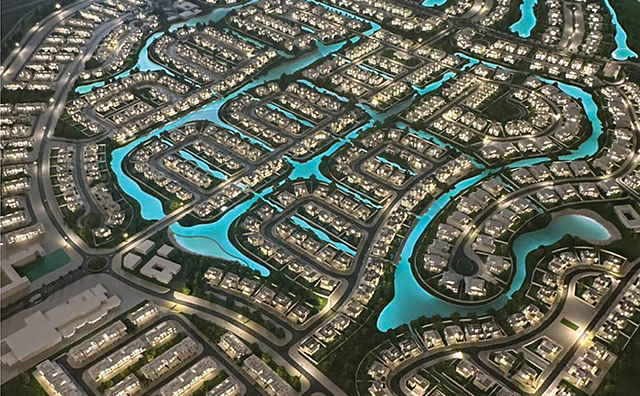 |
|
The Oasis by Emaar will feature more than 7,000 residential units. |
Damac’s latest masterpiece, Altitude is the fourth tower in a series of Dubai Canal waterfront projects that includes Canal Heights 1 and 2 and Canal Crown.Altitude is a branded tower, in partnership with renowned Swiss jewellery brand de Grisogono, as is Canal Heights 2.
Its three master-communities such as Damac Lagoons (see Page 18), Damac Hills and Damac Hills 2 continue to see impressive growth, with contract awards and new launches. Other projects being developed by Damac include the 71-storey Cavalli Tower in Dubai Marina; Damac Bay 2 by Cavalli; Damac Casa in Al Sufouh; and Damac Coral Reef in Dubai Maritime City.
Here is a look at some of the most striking property projects being developed in Dubai:
Burj Azizi: Azizi Developments has unveiled plans to build the second tallest tower – Burj Azizi – in Dubai on a prime plot of land on Sheikh Zayed Road at an investment of $1.5 billion.
Scheduled to be completed within four years, the skyscraper will feature a vertical mall, luxury residences and opulent penthouses in addition to a seven-star hotel, said the developer.The tower will also be home to a one-of-its-kind observation deck as well as numerous high-end food and beverage (F&B) options.
The developer has a string of projects under construction including Riviera, Azizi Central, Azizi Venice (see below), Azizi Grand, Azizi Vista and Beach Oasis.
Azizi Venice: Azizi Developments launched work in May last year on Azizi Venice, its venetian-inspired luxury waterfront lifestyle community, set entirely within a swimmable crystal-blue water lagoon. Located in Dubai South, the AED30-billion high-end mixed-use desert oasis community will feature over 30,000 residential units, including 100 mid-rise apartment complexes and more than 400 villas and mansions.
Among its highlights, the community, which will boast 24 million sq ft of GFA on a 15-million-sq-ft plot of land, will also feature a luxurious temperature-controlled pedestrianised boulevard, Dubai’s second opera and other lifestyle-enhancing amenities.
Azizi is taking on the role as the master developer, in charge of constructing the buildings, roads and all infrastructure of the large-sized mixed-use development.
Azizi Venice will also feature two five-star and one four- star hotels, a full-service hospital, a kindergarten, schools, and a 4-km landscaped main road.
Palm Jebel Ali villas: Dubai developer Nakheel has recently launched one of its most visionary projects, Palm Jebel Ali, on the market with the release of the first villas available to purchase on the island. This follows the unveiling of the island’s futuristic masterplan by HH Sheikh Mohammed in June last year.
Palm Jebel Ali is set on 13.4 sq km of land and boasts the longest coastline of any destination in Dubai.
Dubai Islands: Nakheel has announced the launch of exclusive Bay Villas, on Dubai Islands B, a part of the premier living, entertainment, leisure, and tourism waterfront destination, Dubai Islands.
Dubai Islands comprises five islands with a total area of 17 sq km and 20 km of beaches and encompasses luxurious resorts and culture hubs, located within 20 minutes of downtown Dubai. The new Infinity Bridge links the Islands to the city.
Nakheel has also joined hands with Excelsior Real Estate for the launch of the second phase of its waterfront development – Rixos Dubai Islands, Hotel & Residences – the first luxury hotel and residential offering on Dubai Islands.
Como Residences: Nakheel has launched Como Residences, a new exclusive residential development on Palm Jumeirah that will offer luxurious living experiences.
The 71-storey residential tower standing at over 300 m tall will comprise just 76 residences consisting of two- to seven-bedroom apartments including a spacious duplex penthouse in addition to key amenities such as an elevated private sandy beach, a 25-m lap pool and a rooftop infinity pool. Each floor of the development will be occupied by one or two residences only, served by access-controlled elevators leading to individual private lobbies.
Al Habtoor Tower: The Al Habtoor Group has started construction work on Al Habtoor Tower, which is expected to be the largest residential building in the world with ultra-luxurious living facilities.
Located on the banks of the Dubai Water Canal overlooking the Burj Khalifa, the 81-storey Al Habtoor Tower will comprise 1,701 keys over a built-up area of 3.5 million sq ft. The project, which is being built using innovative construction techniques, is estimated to cost around AED3.7 billion and is scheduled to be completed by mid-2026.According to the developer, once completed, the building’s carbon footprint will be less than half of any similar construction, thanks to the innovative construction technique.
Habtoor Grand Residences: Al Habtoor Group launched its Habtoor Grand Residences, located at Jumeirah Beach in Dubai Marina area, in January this year.
Encompassing 283 units, ranging from two-bedroom apartments to four-bedroom duplex penthouses, each residence offers panoramic sea views. Drawing inspiration from Miami-style architecture, the tower’s dynamic facade harmoniously merges with the surrounding sea views.
The ground-breaking for this 49-storey tower, which covers a footprint of 2,593 sq m, is slated to take place in the coming months, with the project anticipated to be completed by March 2027.
Tilal Al Ghaf: UAE-based Majid Al Futtaim Development is pushing ahead with its flagship lifestyle destination Tilal Al Ghaf, where it has recently launched its final component Amara, a distinctive residential complex featuring 116 private twin villas with interiors curated by The Bergman Design House.
In January, the deverloper awarded contracts worth AED3 billion for two of key residential neighbourhood communities, Alaya and Elysian Mansions. Innovo Build, a part of the ASGC group, will be the primary contractor for the development of Elysian Mansions, while Unec, a leading construction entity in the region, will be responsible for the work on Alaya.
Designed by globally renowned architects and interior designers, Elysian stands as a bespoke community featuring 94 exclusive mansions. Spanning across 200,000 sq m, Alaya neighbourhood boasts 130 grand villas surrounded by spacious landscaped grounds. Both neighbourhoods are anticipated to be completed by mid-2026.
Uptown Dubai: DMCC, a flagship free zone and Government of Dubai Authority on commodities trade and enterprise, has broken ground on the second phase of its Uptown Dubai development, which includes construction of two mid-rise towers (a 23- and 17-storey facility) within the Uptown Dubai district in the southern end of the city.
These towers will offer 753,000 sq ft of Grade A commercial office space as well as 86,000 sq ft food and beverages (F&B) and retail facilities.
This following the successful opening last year of 81-storey Uptown Tower, which is home to 31 of the world’s leading businesses, as well as the hotel rooms and branded residences as part of the urban luxury hotel SO/ Uptown Dubai.
Uptown Dubai will host nine towers, which will encircle the focal point of the district, The Plaza, which will eventually be host to a dynamic and diverse offering of activities from immersive art installations to music, film and fashion performances.
Once completed, Uptown Dubai will boast a total gross floor area (GFA) of 5.8 million sq ft, with 2.5 million sq ft dedicated to commercial office space.
Casa Canal: Dubai developer AHS Properties has joined hands with Fendi Casa for the development of its high-end project Casa Canal being set up at an investment of $850 million alongside the Dubai Canal.
Fendi Casa will provide a high-profile tailored service to combine the highest savoir-faire of the maison with specific interior solutions, both for common areas and the residential units.
The ultra-luxury project will offer units ranging from 4,500 to 30,000 sq ft. Globally-acclaimed interior design firm Hirsch Bedner Associates was entrusted with the design of Casa Canal’s interiors, while the architecture was executed by the renowned Shaun Killa.
Kempinski Floating Palace resort: Work is well advanced on the Kempinski Floating Palace project, which features a floating hotel surrounded by 48 luxury mobile villas, with an estimated market value of AED1.6 billion upon its completion.
El Bahrawy Group, a leading marine construction group in the Middle East, has completed the first of these ‘Neptune’ floating and mobile villa.
Anchored in the Dubai Palm Marina, eight of the 48 Neptune villas available in two-, three-, and four-bedroom configurations, are currently in the final stages of completion. The Kempinski Floating Palace project was initiated three years ago.
Naya at District One: Meydan late last year launched Naya at District One, located in Mohammed Bin Rashid Al Maktoum City.
The development, which is managed by Nakheel, features three distinctive, green-roof towers comprising spacious one- to four-bedroom apartments as well as Lagoon Villas which come with private gardens and terraces.
Set on the shores of what is described as the world’s largest man-made lagoon, Naya at District One is described as a one-of-a-kind resort-inspired oasis of greenery and pristine waters in the heart of Dubai.
South Bay: Construction work has commenced on the first two phases of South Bay project, which is being developed by Dubai South Properties, which has also launched the third phase.
The third phase, which is slated for a Q3 2026 completion, features 213 units comprising villas and mansions.
Located in the heart of Dubai South’s Residential District alongside Expo Road, South Bay will feature over 800 spacious villas and townhouses, more than 200 luxurious waterfront mansions, a 1-km lagoon, more than 3 km of a waterfront promenade. It also features a shopping mall, a renowned spa, kids’ clubs, waterparks, swimming pools, a lake park, and private beaches, among other amenities.
Dubai South has been reinforcing the Residential District with amenities including a British-curriculum school where construction work has already started, public parks; sports courts; retail shops; and a 50,000-sq-ft hypermarket, which opened in March last year. Currently, the Residential District is home to over 25,000 residents.
Keturah: In September last year, UAE developer MAG launched Keturah Business Bay, a AED2-billion luxury tower that proposes residential ‘Bio Living’ within its Keturah, a luxury well-being real estate and hospitality concept. MAG said this new luxury tower offers transformational living through the design of space, being the first in the Middle East to immerse residents in nature through the ‘Bio Living’ concept that incorporates nature into the built environment.
The new tower’s homes boast double-volume interior spaces, which enhance the flow and circulation of naturally cooled air.
MAG is also developing residential homes at The Ritz-Carlton Residences, Dubai, Creekside, a part of the Keturah Resort development, featuring 177 homes across seven buildings and 12 mansions.
Each of these limited-collection housing units adheres to the WELL Certification Standards and is complemented by ultra-high-end leisure areas and exclusive spa and wellness facilities, all of which meet the WELL Health-Safety Rating.
Keturah Resort by MAG is located on Dubai Creek facing Dubai’s wildlife sanctuary in Ras Al Khor.
According to MAG, the Keturah Resort embodies the highest standard of luxury experience offering facilities, including five-star wellness hotel; an immersive, holistic wellness centre; Michelin-star restaurants; 550m promenade; sustainable and organic-focused retail spaces; 24/7 private parking with valet; and a gated community with views of the wildlife sanctuary.
SLS Residences: UAE-based Roya Lifestyle Developments has joined hands with leading lifestyle hospitality group Ennismore for the launch of SLS Residences at Palm Jumeirah. The project, set to open in 2026, is the first standalone SLS-branded residences outside the Americas.
Situated atop the West Crescent, the branded residences will boast 113 units with varying layouts and configurations.
Luce: Another exquisite residential development coming up on the Palm Jumeirah is Luce being developed by Taraf, the real estate division of UAE-based investment holding group Yas Holding. Luce spreads over two low-rise buildings housing one- to three-bedroom apartments and 60 per cent of the property is allocated to open and green spaces, stated the developer.
Burj Binghatti Jacob & Co. Residences: UAE real estate developer Binghatti and leading jewellery and horology brand Jacob & Co are jointly developing – the Burj Binghatti Jacob & Co. Residences, which is aimed to be world’s tallest residential structure.
The proposed design comprises over 100 storeys that feature two- and three-bedroom residences. The top of Burj Binghatti Jacob & Co Residences hosts five of the most luxurious and exclusive penthouses in Dubai. The interiors of the building’s mansions and villas draw their inspiration from the grand jewellery and horology masterpieces Jacob & Co. is renowned for.
Bugatti Residences by Binghatti: Binghatti is collaborating with Bugatti to launch the global luxury brand’s first residential development in the world – Bugatti Residences by Binghatti – in the prime Business Bay area. It will offer a collection of 171 Riviera Mansions and 11 Sky Mansion Penthouses, each unique with bespoke curated layouts.
DG1: Dar Global, a luxury real estate developer which is headquartered in Saudi Arabia, last year launched its inaugural own-brand luxury living concept, DG1. Nestled in the heart of Business Bay, DG1 will boast captivating views of the Dubai Canal and Burj Khalifa.
Gensler Architects has designed the 20-storey tower, which comprises 221 units, including one-, two- and three-bedroom apartments.
Meanwhile, Dar Global has awarded the fit-out works for the Da Vinci Tower at Business Bay to the regional unit of Indian construction and real estate conglomerate Shapoorji Pallonji.
An AED800 million project, Da Vinci Tower features 80 exclusive apartments and a luxurious penthouse. The avant-garde design of the Da Vinci Tower is by Pagani. The tower is expected to be completed in December 2025.
Baccarat Residences: Luxhabitat Sotheby’s International Realty has launched the Exclusive Baccarat Residences, a residential complex, in Downtown Dubai, which will boast 49 ultra-luxury apartments across 24 floors.
The Baccarat Residences offer generously spacious and intimate homes with an iconic design. Owned by Shamal, the crystalline tower creates a majestic presence that shines bright amidst the city’s skyline.
Sobha Hartland II: Sobha Realty launched its new flagship mixed-use community – Sobha Hartland II – in June last year aimed at redefining luxury waterfront living.
Spread over an 8-million-sq-ft area, the project is located next to Sobha Hartland and consists of five- and six-bedroom villas as well as one- to four-bedroom apartments with more than 30 per cent of the area dedicated to open and green spaces.
- Soaring to new heights
- $46bn lifestyle destinations
- Dorchester dwellings
- Mediterranean sanctuary
- Mered gives flight to Iconic vision
- Outsourcing brings key benefits: Addmore
- Hansgrohe’s products, green drive win praise
- Dubai projects at a glance



